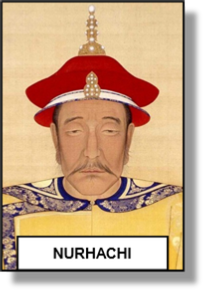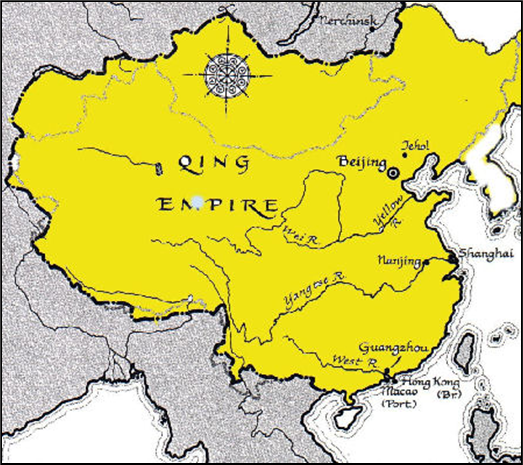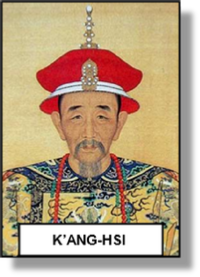


THE MANCHU (QING or CH’ING) DYNASTY
in CHINA 1644 (C1)
Acknowledgements
Nurhachi: detail, 17th century, artist unknown – Palace Museum, Beijing. Map (China): licensed under Creative Commons – https://apworldhistorywiki.wikispaces.com. K’ang-
Including:
Nurhachi
(Kundulun Khan)

xxxxxThe Ming Dynasty, founded in 1368 (E3), reached the height of its power under emperor Yung Lo around 1414 (H5). In 1499, however, the Western Mongols defeated a Ming force near Peking, and in 1521 a reign of terror brought the empire near to collapse. By 1550 (E6) the empire was under constant attack. The end came following the rise of the Qing dynasty in Manchu, founded by its leader Nurhachi (later Kundulun Khan). He took over parts of the Ming Empire and his son, Prince Dorgon advanced towards Peking in 1638. Amid the anarchy that followed a Ming commander invited the Manchu into the city to restore order. They entered and stayed. The Ming Dynasty was at an end by 1644, though resistance continued for some years. The Manchu Dynasty lasted until 1911 but it was many years in decline. As we shall see, its first great leader was K’ang-
C1-
 xxxxxThe Ming Dynasty or "Brilliant Dynasty" of China was founded in 1368 (E3) and reached the height of its power in the early years of the fifteenth century under its greatest emperor Yung Lo (1414 H5). By the end of his reign, however, Mongol attacks along China's northern borders had become more frequent, and in 1499, during the reign of Cheng-
xxxxxThe Ming Dynasty or "Brilliant Dynasty" of China was founded in 1368 (E3) and reached the height of its power in the early years of the fifteenth century under its greatest emperor Yung Lo (1414 H5). By the end of his reign, however, Mongol attacks along China's northern borders had become more frequent, and in 1499, during the reign of Cheng-
 xxxxxYet again, the empire managed to survive and, under Chia-
xxxxxYet again, the empire managed to survive and, under Chia-
xxxxxHis successor on the battlefield, his son Prince Dorgon, did advance further. In 1627 the Manchu overran the Korean peninsula and began to cross the “Great Wall of China”, advancing close to Peking in 1629 and 1638. The Ming Empire, burdened with heavy taxation and struck by famine, now began to break up, and in April 1644, amid total anarchy, a peasant rebel named Li Tzu-

xxxxxMing loyalists held out in parts of the south for some forty years and those on the island of Taiwan until 1683, but the Qing dynasty had come to stay. It provided sound government for some 150 years, but it then went into a long period of decline and was eventually overthrown in 1911. During its long reign, the Chinese empire reached its greatest extent, including all of China, the four great dependencies of Manchuria, Mongolia, Sinkiang (Xinjiang) and Tibet, and a number of tributary states such as Nepal, Burma and Korea. As we shall see, the first of its great Emperors was K'ang-
xxxxxThe fall of the Ming dynasty marked the end of the great age of extremely fine Chinese porcelain, but Qing China was not without quality products. Over the next hundred years it was to export vast quantities of household porcelain (or china) to Europe, together with fine silk, cheap but good quality cotton goods, and large quantities of tea.


